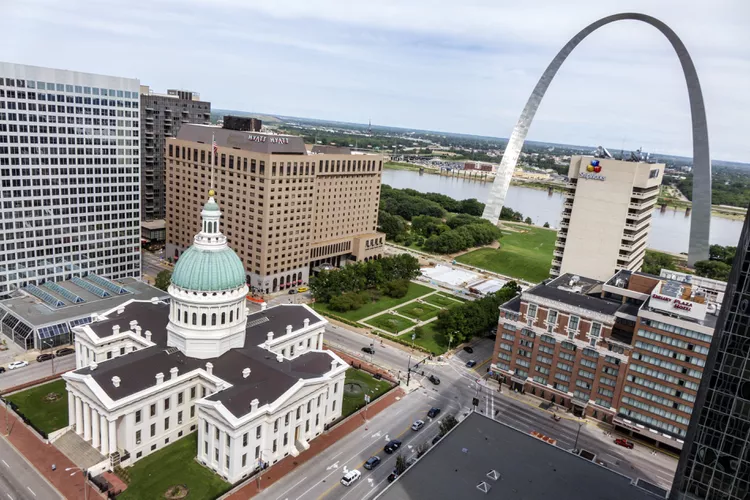Summary
Nearly every visitor to St. Louis marvels at the Gateway Arch and explores the zoo, the art museum, or one of the other historic institutions located in Forest Park. However, no visit to the Gateway to the West is complete without discovering a few of the city’s many distinctive neighborhoods. There are 79 within the city limits alone, with many more worthwhile spots as you head west into the greater metro area. Therefore, here’s your guide to what to see and do in 10 of the best neighborhoods in St. Louis.
Soulard
:max_bytes(150000):strip_icc():format(webp)/GettyImages-625936132-4a90f71a0bd941539afe012e5e842856.jpg)
Located just south of downtown St. Louis, the Soulard Farmers Market is one of the best-known markets in the city. Established in 1841, the market serves as a vibrant hub where farmers sell their goods. The Soulard neighborhood itself is known for its nightlife and hosts a large Mardi Gras celebration each year. For dinner or drinks, check out Bogart’s Smokehouse, John D. McGurk’s Irish Pub, or Molly’s in Soulard. Additionally, the area is a great starting point for exploring Cherokee Street’s antique stores and vibrant Mexican-American community.
Shaw
:max_bytes(150000):strip_icc():format(webp)/GettyImages-92206526-0ac8f647a4aa4823a315019328c1342a.jpg)
Three miles west of Soulard, just south of Interstate 44, the Shaw neighborhood is surrounded by three of St. Louis’ most historic green spaces: the Missouri Botanical Garden, Compton Hill Reservoir Park, and Tower Grove Park. Named after philanthropist Henry Shaw, the area features tree-lined streets and Victorian houses. After undergoing a renaissance, Shaw is now home to many small businesses and eateries, including Future Ancestor, Bonboni Mercantile Co., Fiddlehead Fern Café, and Ices Plain & Fancy.
Central West End
:max_bytes(150000):strip_icc():format(webp)/GettyImages-997279986-643d381fe63c4ff89cb91a348e133d17.jpg)
The Central West End hugs the northeastern corner of Forest Park and is renowned for some of St. Louis’ most impressive historic houses. Wealthy residents built stately mansions during the early 20th century, many of which endure today. With its pedestrian-friendly area, the Central West End stretches from the upscale Chase Park Plaza Royal Sonesta Hotel to the glittering Cathedral Basilica of Saint Louis. While exploring, consider visiting the World Chess Hall of Fame, enjoying a cupcake from The Cup, or browsing at Left Bank Books.
The Grove
:max_bytes(150000):strip_icc():format(webp)/The_Grove_10602410245-57b7df9bc9c54c6eaa28a204e8cdc164.jpg)
A large, light-up sign hangs over Manchester Road, marking the start of The Grove—a mile-long stretch from the southeastern corner of Forest Park. This burgeoning neighborhood is one of the most LGBTQ-friendly areas in St. Louis, featuring numerous bars and nightclubs like Just John Club and Atomic Cowboy. Additionally, it boasts notable restaurants, including Urban Chestnut Brewing Company’s German-style bierhall, Southern eatery Grace Meat + Three, and gourmet burger spot Layla. The Grove buzzes with street art and activity, showcasing several interesting murals.
The Hill
:max_bytes(150000):strip_icc():format(webp)/The_Hill_Fire_Hydrant-59d9738bc3a641c6b038afb5825dc63f.jpg)
Italian flag-painted fire hydrants denote the start of The Hill, a traditionally Italian-American neighborhood less than a mile south of Forest Park. This area has a rich history, having been settled by Italian immigrants in the late 1800s. Today, The Hill is dotted with Italian eateries, bakeries, and specialty stores—many of which are still family-run. For a taste of authentic Italian cuisine, visit Charlie Gitto’s on The Hill, Favazza’s Restaurant, Zia’s Restaurant, or Gioia’s Deli. Additionally, The Hill is an excellent place to try toasted ravioli, a beloved St. Louis dish.
The Delmar Loop
At the end of what used to be St. Louis’ streetcar line, the Delmar Loop has transformed into a vibrant hotspot for dining, shopping, and entertainment. While exploring, look for bronze stars honoring prominent St. Louisans and browse one-of-a-kind shops like Vintage Vinyl. Consider catching an independent film at the elegant Tivoli Theatre, trying St. Louis-style barbecue at Salt + Smoke, or relaxing at Blueberry Hill, a dining and music venue where Chuck Berry performed frequently. The Loop is particularly popular among younger crowds, especially students from nearby Washington University in St. Louis.
Maplewood
:max_bytes(150000):strip_icc():format(webp)/Manchester_Road_Maplewood_Missouri-0419a70f053f4ab78aff2b46cd9b7670.jpg)
St. Louisans are known for their appreciation of craft beer, evident at Schlafly’s Bottleworks in Maplewood, Missouri. Visitors can tour the facility to understand Schlafly’s brewing process and sample a rotating selection of beers. Along Manchester Road, the neighborhood is home to many small businesses, including Kakao Chocolate, Leopard Boutique, and specialty food store Larder and Cupboard. Notably, Maplewood is also home to Mauhaus, the city’s first permanent cat café. Make sure to check out the Route 66 plaques along Manchester before dining at Reeds American Table or The Benevolent King.
Downtown Clayton
Clayton, Missouri, became the county seat in 1877 and has evolved into St. Louis County’s preeminent business district. The area is home to major corporations like Caleres and Centene Corporation. Bordered by Interstate 170 and connected by the MetroLink transit system, Clayton features expansive Shaw Park, historic homes, and upscale boutiques and restaurants, including popular brunch spot Half & Half, and Italian eateries Pastaria and Il Palato. Each September, Clayton hosts the Saint Louis Art Fair, attracting around 130,000 visitors.
Kirkwood
:max_bytes(150000):strip_icc():format(webp)/12627316165_94afbe80cf_o-8aef0acb0f5647f8995f821dd22bcfed.jpg)
Kirkwood, Mo., established in 1853 as a commuter suburb, continues to be a hub for passengers because it is one of only two places in the St. Louis metro area with an Amtrak station. The community showcases 100-year-old Victorian houses and a pedestrian-friendly downtown filled with boutiques, restaurants, and a popular farmer’s market. While visiting, enjoy coffee at Kaldi’s Coffee Roasting Co., savor a gooey butter donut from Strange Donuts, or unwind with a local beer at Billy G’s. Families can also explore The Magic House, an interactive museum for children just a short drive away The Magic House.
St. Charles
Just across the Missouri River, St. Charles is a western suburb founded in 1769, shortly after St. Louis. Known for its historic sites, casinos, and access to Katy Trail State Park, visitors are drawn to its quaint charm along cobblestone-lined Main Street. While there, consider dining at Hendrick’s BBQ, or Lewis & Clark’s Restaurant for a delightful culinary experience.




